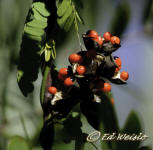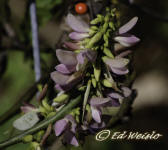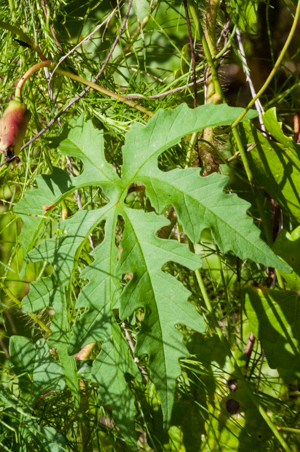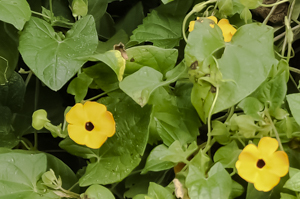Florida Vines
Rosary Pea, Air Potato, Coral Vine, Golden Pothos, Bitter Melon, Puncture Weed, Noyau Vine, Bleeding Heart Vine, Milkweed Vine, Black-eyed Susan Vine
Rosary pea - Abrus precatorius


Invasive / Exotic
Family - Fabaceae
Habitat - Ruderal, Flatwoods, Hammocks
Extremely poisonous, the distinctive red and black seeds of this vine can be fatal if eaten.
Listed as a category 1 invasive species. Climbing, twining or trailing vine with small alternate, compound leaves having 5-15 pairs of oval to oblong leaflets with entire margins.
Flower - Pea-like white to reddish flowers in dense clusters at leaf axils. Fruit is a short oblong pod which splits open at maturity to reveal the scarlet and black seeds.
Air potato - Dioscorea bulbifera
_small.jpg)
_small.jpg)
Invasive / Exotic
Family - Dioscoreaceae
Habitat - Margins of forests, particularly in moist areas
Description - Introduced invasive twining vine, fast growing to 60 70 feet, covering and shading out native plants. Long stalked, cordate alternate leaves to 8 inches long with palmately arranged veins. Produces aerial tubers from leaf axils from which new plants develop.
Flower - Usually not present in Florida.
Coral Vine - Antigonon leptopus
%20copy_small.jpg)

Invasive / Exotic
Family - Polygonaceae
Habitat - Disturbed areas, roadsides, hammocks.
Description - Introduced category 2 invasive species, reaching lengths of 30 to 40 feet and climbing by tendrils. Cordate leaves are up to 4 inches long with entire, slightly undulate ( wavy ) margins. The upper leaf surface has recessed veins & wrinkled appearance.
Flower -Racemes of tiny flowers with larger colorful sepals, varying from pink to coral to white are produced in summer.
Golden Pothos - Epipremnum pinnatum L.
Engl)%20_small.jpg)
Engl)%20_small.jpg)
Invasive / Exotic
Family - Araceae
Habitat - Hammocks - coastal and inland
Description - Introduced climbing vine to 30 feet or more, often growing on Sabal Palms, leaves are alternate, ovate, average 18 inches long up to 36 inches. This vine is commonly sold as a potted plant in garden centers and as such usually has a much smaller stature with leaves rarely exceeding 4-5 inches.
Bitter melon, Balsam apple - Momordica charantia


Invasive / Exotic
Family - Cucurbitaceae
Habitat - Ruderal, fence-lines, hammocks, orange groves.
Description - Introduced annual creeping or climbing herbaceous vine. Leaves alternate, deeply palmately cut with five to seven lobes, may be hairy or smooth, margins usually toothed. Often appears as a yard weed and can be quite persistent if allowed to self seed. A related species, Momordicabalsamina L. is sometimes cultivated.
Flower - A solitary yellow flower is produced on stalks, produces an egg shaped, ribbed fruit with a bumpy surface, 3-4 inches long, golden yellow to bright orange, splitting open when mature to reveal bright red arils which contain seeds.
Puncture Weed, Battle axes - Tribulus cistoides


Exotic
Family - Zygophyllaceae
Habitat - Sandy areas, disturbed sites, very common roadside plant.
Description - Introduced. Perennial Vine, Sub-shrub, Forb, herb. Forms thick mats, 2-8 inches in height, leaves pinnately compound. This is one reason not to barefoot in Florida!
Flower - Yellow, 1 1/2-2 inches across, fruit is a small spiny brown hard nut that resembles a "battle axe" of the middle ages.
Noyau vine - Merremia dissecta

_small.jpg)
Family - Convolvulaceae
Habitat - Ruderal
Description - Native vine found throughout Florida. Twining vine with hirsute stems, leaves are deeply palmately lobed.
Flower - 3-4 inch white tubular flower with reddish center
Bleeding Heart Vine - Clerodendrum thomsoniae
_small.jpg)
2_small.jpg)

Invasive / Exotic
Family - Lamiaceae
Habitat - Ruderal, can be found around old home sites, escapes from cultivation in the southern part of the state.
Description - Not native, introduced perennial twining vine up to 20 feet or more in length. Leaves are alternate, ovate to slightly cordate with entire margins.
Flower - Clusters of flowers with crimson red petals, equal or slightly larger white or sometimes purplish sepals. Long protruding (exserted) stamens.
Black-eyed Susan Vine - Thunbergia alata


Exotic
Family - Acanthaceae
Native to tropical and southern Africa, imported as an ornamental garden plant, naturalized in Florida.
Perennial climbing vine up to 16 feet in length, leaves are up to 3 inches long and highly variable, they may be hastate to ovate with entire or toothed margins. Underside of leaf is hairy along veins, upper surface may be slightly hairy or glaborus. Leaves are arranged oppositely on slim stems.
Tubular flowers 1 1/2 inches across (+/-) are predominately yellow or orange with a deep violet throat and 5 petals.
Milkweed vine - Morrenia odorata


Invasive / Exotic
Family - Apocynaceae
Native to S. America. Perennial, twining, climbing vine with greenish white flowers. Produces large pods that split open at maturity, releasing hundreds of seeds with tiny silken hairs that aid in seed dispersal by the wind.
Leaves are cordate to hastate, new growth and stems are grey-green in color and pubescent. This vine is considered a pest in Florida orange groves, it was actually first found wild in a Florida orange grove in 1957 possibly as an escapee from a nearby house plant. Bleeds a white, sticky sap when a stem is broken as other members of the milkweed family.